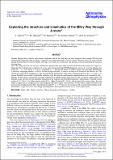Por favor, use este identificador para citar o enlazar a este item:
http://hdl.handle.net/10261/347862COMPARTIR / EXPORTAR:
 SHARE SHARE
 CORE
BASE CORE
BASE
|
|
| Visualizar otros formatos: MARC | Dublin Core | RDF | ORE | MODS | METS | DIDL | DATACITE | |

| Título: | Exploring the structure and kinematics of the Milky Way through A stars |
Autor: | Ardèvol, J.; Monguió-Tortajada, Marta; Figueras, Francesca; Romero-Gómez, Mercè; Carrasco, J. M. | Palabras clave: | Galaxy: disk Galaxy: structure Galaxy: kinematics and dynamics Catalogs |
Fecha de publicación: | 2023 | Editor: | EDP Sciences | Citación: | Astronomy and Astrophysics 678: A111 (2023) | Resumen: | [Context] Despite their relatively high intrinsic brightness and the fact that they are more numerous than younger OB stars and kinematically colder than older red giants, A-type stars have rarely been used as Galactic tracers. They may, in fact, be used to fill the age gap between these two tracers, thereby allowing us to evaluate the evolutionary and dynamic processes underlying the transition between them. [Aims] We analyse Galactic disc structure and kinematic perturbations up to 6 kpc from the Sun based on observations of A-type stars. [Methods] This work presents a catalogue of A-type stars selected using the IGAPS photometric survey. It covers the Galactic disc within 30° ≤l ≤ 215° and |b|≤5° up to a magnitude of r ≤ 19 mag with about 3.5 million sources. We used Gaia Data Release 3 parallaxes and proper motions, as well as the line-of-sight velocities, to analyse the large-scale features of the Galactic disc. We carried out a study of the completeness of the detected density distributions, along with a comparison between the b < 0° and b > 0° regions. Possible biases caused by interstellar extinction or by the usage of some kinematic approximations were examined as well. [Results] We find stellar overdensities associated with the Local and the Perseus spiral arms, as well as with the Cygnus region. We find that A-type stars also provide kinematic indications of the Galactic warp towards the anticentre, which displays a median vertical motion of ∼6 − 7 km s−1 at a Galactocentric radius of R = 14 kpc. It starts at R ≈ 12 kpc, which supports the scenario where the warp begins at larger radii for younger tracers when compared with other samples in the literature. We also detect a region with downward mean motion extending beyond 2 kpc from the Sun towards 60° ≲l ≲ 75° that may be associated with a compression breathing mode. Furthermore, A-type stars reveal very clumpy inhomogeneities and asymmetries in the VZ − Vϕ velocity space plane. |
Versión del editor: | https://doi.org/10.1051/0004-6361/202346925 | URI: | http://hdl.handle.net/10261/347862 | DOI: | 10.1051/0004-6361/202346925 | E-ISSN: | 1432-0746 |
| Aparece en las colecciones: | (ICE) Artículos |
Ficheros en este ítem:
| Fichero | Descripción | Tamaño | Formato | |
|---|---|---|---|---|
| explorstars.pdf | 2,31 MB | Adobe PDF |  Visualizar/Abrir |
CORE Recommender
SCOPUSTM
Citations
2
checked on 20-abr-2024
Page view(s)
14
checked on 01-may-2024
Download(s)
2
checked on 01-may-2024
Google ScholarTM
Check
Altmetric
Altmetric
Este item está licenciado bajo una Licencia Creative Commons

